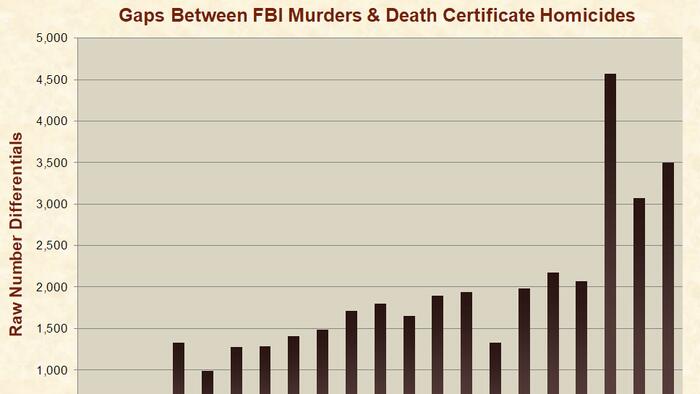In the United States, tracking homicide data involves two primary national collection systems: death certificates compiled by the Centers for Disease Control and Prevention (CDC) and local law enforcement reports aggregated by the Federal Bureau of Investigation (FBI). Historically, the information provided by death certificates has been more comprehensive and accurate than the statistics reported by the FBI. However, under the Biden administration, the discrepancy between these two data sets has significantly widened, raising concerns about the potential underreporting of homicides by local law enforcement agencies and the FBI. The alterations to previously reported murder data since Biden took office have exacerbated this issue, with reports showing an increase in murder counts by as much as 7% retroactively dating back to 2003. These revisions occurred without public acknowledgment in the form of footnotes, leading to increased scrutiny regarding the accuracy of homicide statistics during this administration.
Murder is regarded as the most serious and measurable crime, noted for its unequivocal outcomes—namely, the existence of a deceased individual. However, challenges arise in the methodologies used to measure homicide rates, especially when comparing the two primary sources. The Bureau of Justice Statistics has noted that death certificates, which report homicides systematically and include cases from federal jurisdictions, provide a clearer view of homicide trends than the FBI’s voluntary reporting system. These death certificates encapsulate a wider range of homicide situations, including those that may not be traditionally counted by local law enforcement due to oversight or the nature of the incidents. While death certificates occasionally overcount murders—particularly in cases involving unintentional fatalities—historical comparisons indicate a consistent pattern where death certificates report higher homicide rates than FBI data.
The revisions made by the Biden-era FBI regarding murder statistics have become increasingly contentious, particularly due to the scale of alterations stretching across nearly two decades. Traditionally, the FBI updates crime data on an annual basis, issuing revisions primarily to the previous year’s data along with footnotes to inform the public. For instance, in 2020, the FBI adjusted its murder count for 2018 with a footnote indicating the change. In stark contrast, 2023 saw the FBI revise annual murder counts from 2003 onward, resulting in notable discrepancies, including a jump in the 2003 count by over 1,000 murders. Interestingly, despite the substantial revisions, only the 2021 data received footnote acknowledgment, prompting allegations of a lack of transparency regarding the changes.
Analyzing historical trends of the murder data under previous administrations uncovers significant differences in how the FBI has handled homicide data. Research indicates that during George W. Bush’s presidency, the gap between FBI-reported murders and death certificate homicides remained relatively stable. However, some increases in earlier years can be attributed to the FBI’s adjustments in count. Under Barack Obama, the gap widened slightly but remained consistent with earlier patterns, as previous data generally went unchanged except for minor adjustments. Yet during the Biden administration, the number of homicides not reported by the FBI surged to an average of 3,711 annually, revealing a stark increase in unrecorded or underreported homicides relative to death certificates.
The potential implications of these discrepancies are profound, as accurate homicide data is critical for understanding crime trends and informing policy decisions. The significant gap between death certificates and FBI data suggests that there is likely underreporting or methodological flaws within law enforcement reporting structures. As public safety policies often rely on statistical data to justify interventions, inaccuracies in measuring homicides could lead to misguided strategies that ultimately fail to address the issues at hand. Moreover, the inconsistencies in how historical data are presented raise questions about the reliability of crime statistics used for policy-making and public discourse.
In conclusion, the evolving landscape of homicide data under the Biden administration emphasizes the importance of transparency and accuracy in crime reporting. The pronounced gap between authoritative sources like the CDC and the FBI highlights possible deficiencies within local law enforcement operations and the FBI’s data handling. The significant retroactive adjustments made to murder statistics, particularly without sufficient public notice, could undermine public trust in statistical reporting. Continued scrutiny of the systems in place is essential to ensure that the measurement of homicides reflects reality, thereby facilitating informed policy decisions that can effectively address crime in the United States. Addressing these gaps is crucial for promoting public safety and restoring confidence in the statistical data that underpin crime analysis and prevention efforts.

